Tamron’s New VC Image Stabilization
Tamron’s new VC Vibration Compensation system works great. I was able to consistently shoot three shutter speeds slower with the VC turned on. A few months ago I had a loaner Canon EF 28-300mm f/3.5-5.6 L IS lens and based on my touchy-feely memory of that lens, I think Tamron’s VC image stabilization works as well or better than the Canon system. The first time I zoomed the Tamron to 300mm and the shaky image in my viewfinder snapped to attention, I was sold. Unfortunately, I can’t do a head-to-head comparison. But even if the Tamron isn’t as good, the fact that I can even compare the two lenses says a lot. The Canon 28-300mm L and Tamron 28-300mm VC lenses are in a very different class, both in terms of price and optics. If the $600 Tamron compares at all favorably with a $2500 Canon L-Series superzoom, I think Tamron has reason to be proud.
 |
 |
| Tamron’s Vibration Compensation (VC) image stabilization works great! Left: 1/6th second at 28mm Right: 1/30th second at 218mm (click on photos for larger versions) |
|
Adding image stabilization to their lens line is great for Tamron. Their high-end lenses without image stabilization already get excellent reviews from PhotographyREVIEW.com members. But image stabilization offers big benefits besides just sharper photos. Being able to shoot at slower shutter speeds gives photographers more exposure options. It allows you to use smaller apertures for increased depth-of-field. And most importantly, it allows use of lower ISO settings for less noise and better overall image quality. Being able to use shutter speeds three stops slower meant I never had to go over ISO 400 with the Tamron AF28-300mm XR Di VC lens.
For more on image stabilization, see Sebastian Szyszka’s excellent Image Stabilization Guide.
Tamron 28-300mm F/3.5-6.3 XR Di VC Image Quality
After my first day with the Tamron, I couldn’t wait to see if the 28-300′s optics would live up to the feel and performance. I loved the huge zoom range and VC image stabilization performance! But build quality, feel, and image stabilization don’t make any difference if the image quality isn’t there. During the time I had the lens I shot portraits, landscapes, flowers, and mountain bike photos, wide, telephoto, and close-ups. Overall, I would call the image quality good. The images are definitely softer than I am used to and there is noticeable chromatic aberration. They are usable. But I have to admit that when I first saw them on the computer, I was a little disappointed. To be fair, I have some pretty good lenses, and the only zoom with this range that I’ve used is the $2500 Canon EF 28-300mm f/3.5-5.6L IS. So my standards are pretty high. Keeping that in mind, and adjusting expectations accordingly, the Tamron AF28-300mm F/3.5-6.3 XR Di VC lens isn’t bad. Is it as good as my Tamron AF28-75 f/2.8 XR Di or the Canon EF 28-300mm f/3.5-5.6L? Hell no. But for a lens with this kind of reach that’s the size of the Canon 28-135mm IS and costs $600, it would be a little crass to complain that it’s not as sharp as a pro lens. It just might not be the right lens for working pros who value image quality above all else.
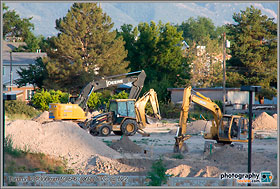 |
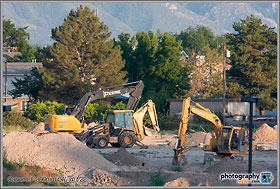 |
| Tamron AF28-300mm VC @ 300mm |
Canon EF 300mm f/4L @ 300mm |
 |
 |
| Tamron AF28-300mm VC detail |
Canon EF 300mm f/4L detail |
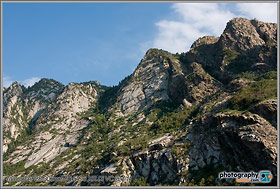 |
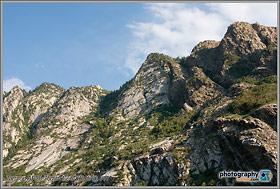 |
| Tamron AF28-300mm VC at 28mm |
Tamron AF28-75mm f/2.8 XR Di lens at 28mm |
 |
 |
| Tamron AF28-300mm VC at 28mm – 100% detail |
Tamron AF28-75mm f/2.8 XR Di lens at 28mm – 100% detail |
In a brick wall comparison with my Tamron 28-75mm f/2.8 XR Di, the Canon EF 70-200mm f/2.8L, and the Canon EF 300mm f/4L it’s clear that the Tamron 28-300mm VC lens isn’t the sharpest of the bunch. It’s also less contrasty and chromatic aberration is pretty obvious. The best image quality is at about 70-80mm and f/8 or 11. There’s also some distortion at the wide end of the zoom, although it’s not that bad. Ultimately, considering the zoom range and price, I think the Tamron 28-300mm VC lens compares pretty favorably to the $3000 of glass I tested it against.
While testing I discovered some interesting anomalies. The Tamron 28-300mm VC lens underexposes by about half a stop compared to the other three lenses. It’s also on the optimistic side as far as focal length goes. This is most obvious when comparing to the Canon EF 70-200mm f/2.8L and the Canon EF 300mm f/4L. With the 70-200, I had to back off the zoom to 175mm to match the angle-of-view of the Tamron at 200mm. And the Canon EF 300mm f/4L is tighter than the Tamron is at its maximum focal length. I don’t think the underexposure or shorter focal length is a real problem. But it’s good to know about them before you buy the lens. And photographers who are really picky about exposure will want to test the exposure accuracy of the lens to see if they need to bump up the exposure compensation a bit.
My usual advice to photographers looking at superzoom lenses in this range is to buy something shorter because so many optical compromises need to be made when the zoom ratio gets this big. Of course, if you spend a fortune, you can get monster zooms that perform. But if you’ve got $600 and want this kind of zoom range I think the Tamron 28-300mm VC is a good compromise – maybe even a great lens when you consider the excellent Vibration Compensation performance.
The Verdict
Photographers on a budget who want a do-it-all lens, or travel photographers who need to travel light will appreciate the Tamron 28-300mm f/3.5-6.3 XR Di VC lens. You will have to sacrifice some sharpness, though. Personally, I would rather give up the 300mm reach and carry two sharper lenses. But if size or price are limitations, then it could very well be a good compromise. If you want a sharper lens with this zoom range and image stabilization, be prepared to pay about four times the Tamron’s $600 price tag.
For those of us who are using APS-C sensor cameras like the Canon EOS 40D or the Nikon D60, a slightly shorter version of this lens with a truly wide angle-of-view would be nice. (See article and press release for the planned Tamron 15x AF18-270mm F/3.5-6.3 Di II VC MACRO Lens) But I have definitely been in situations where the Tamron’s zoom range, size and Vibration Compensation would have made it the perfect lens – even if it is softer than other lenses I own.
The most exciting thing about this lens is Tamron’s Vibration Compensation image stabilization. It works great and transforms a 28-300mm consumer zoom lens into something kinda special. I’m really looking forward to seeing the VC image stabilization integrated into some of Tamron’s better lenses, like the AF28-75mm f/2.8 XR Di and the AF70-200mm f/2.8 Di LD (IF) Macro zoom. Having high quality alternatives to expensive Canon and Nikon glass is always good. Tamron’s high-end lenses are excellent. And with the addition of Vibration Compensation, I think they can expect to sell a lot more of them.
Related Content:
The Tamron AF28-300mm F/3.5-6.3 XR Di VC Lens User Reviews
All Tamron Lens Reviews
Tamron AF28-300mm F/3.5-6.3 XR Di VC Sample Photo Gallery
All Zoom Lens User Reviews
Digital SLRs Forum
Image Stabilization Guide
Tamron Lens Web Site
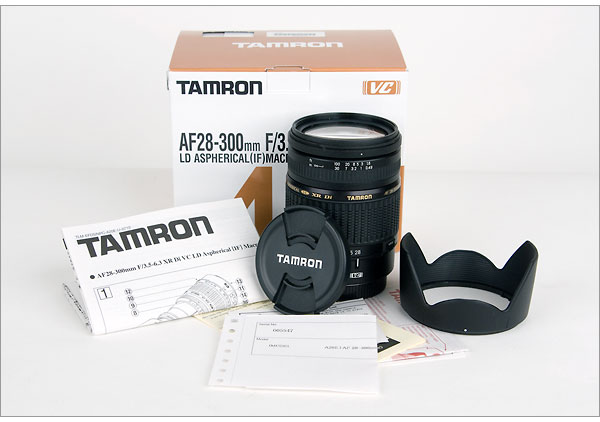


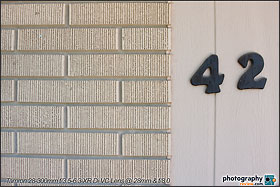
Pingback: Tamron 15x AF18-270mm F/3.5-6.3 Di II VC MACRO Lens
Pingback: Tamron AF28-300mm Di VC European Consumer Lens of The Year
Pingback: Tamron SP AF10-24mm F/3.5-4.5 Di II LD - 2.4x Ultra Wide-Angle Zoom Lens
Well, I actually need suggestion on this lens for I am considering to have this one, plugged into my nikon d90.
A well written review, thank you.
I have just ordered this along with my D700 – Lets see how they perform together.
Best regards,
Michael Nielsen
i am planning to buy this lens but confused if they have a different one for Canon mount than the Nikon mount. does it make a difference? do i have to mention it specifically on my order? i have a canon rebel XS… your comments will be appreciated.
Yes, each camera maker uses their own lens mount and you do need to specify when you order or the lens won’t fit. If you order online the order process should have you choose your lens mount. If it doesn’t, I think I’d look for a different dealer because that’s not an indication that they understand cameras.
Before you buy any camera online, make sure to check our Camera Dealer Feedback forum. There are tons of sleazy online camera dealers out there trying to make a quick buck. It’s best to shop by dealer reputation and not by price. If the price is too good to be true, it most likely is a scam.
If you really care about very sharp photos, don’t buy this one. I have tried every setting available and even with the VC off, the mirror up on my Canon40D and using a tripod, the pictures are very soft.
What happens when you plug in an extender?
Randy-
You can use a tele-extender with this lens. Depending on the extender and the what you’re zoomed to, you’ll be looking at maximum apertures as slow as f/11. You’ll also likely see some compromised image quality. Since this lens is already a bit of a compromise, using a tele-extender might yield pretty poor results. I wouldn’t want to use more than a 1.4x extension and even then you might end up disappointed. The only way to know for sure is to try it, though.
Does this come on a Pentax mount?
hi i’m new in photography, i would like to buy this lens (reasons : easy to use lens, all-in-one)
i study in college, advertising program
so my photography skill will be used for advertising,
is it the right lens for me ? if not, why ? you have any suggestion for another all-in-one (wide to telephoto) lens ?
kiki-
I think this would be a fine lens for you. However, I prefer the 18-200mm zoom lenses because I think they have better optics. If you think you really need the 300mm telephoto end then this is a good, inexpensive option. But if image quality is a priority for you, then get something shorter.
Photo-John -
ohh, i’ve read many review about lenses, and i just found a better lens, Tamron 18-270mm, many people says it have better image quality than this lens, but i also find a multipurpose lens at SIGMA lens, and i found the 18-250 lens, it have better feature, and also cheaper, but it also heavier and bigger
i confused to choose one of both, but i think i’d prefer the tamton lens to sigma lens, cause they have better reputation, IMO
Has anyone tried it on the Canon 5D Mark II, if so what is the report ?
Does it work or not?
WHat if any problems you encountered?
Waiting for inro..